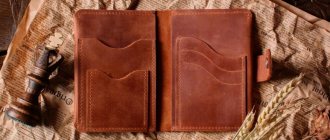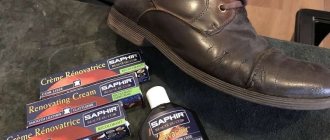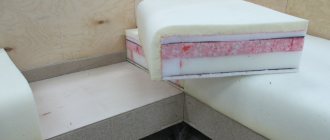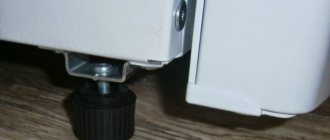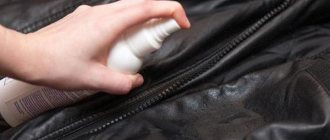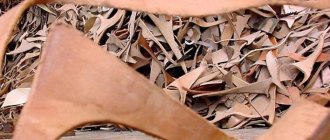How to distinguish natural leather from artificial leather? People are puzzled by this question when they go shopping for new shoes, a purse, a bag, a raincoat or a jacket. The times in which it was possible to identify an imitation passed off as leather only by looking at the product are long gone. It is quite difficult to distinguish modern analogues of leather from natural ones, which is what unscrupulous sellers take advantage of.
Detailed article on the topic Pressed leather and its difference from real leather
But, despite the high quality of artificial materials, they are not identical to natural ones. Differences between leather and substitutes can be detected when purchasing items, you just need to know what exactly to look for. Of course, it is also necessary to imagine the characteristics that characterize materials.
Advantages of genuine leather products
Products made from genuine leather look much better and more solid than those made from leatherette. In addition, they are durable and practically do not wear out during long-term wear.
Genuine leather is highly durable. For example, a travel suitcase made of leatherette may burst if you put too many things in it. This will not happen with natural material.
Products made from genuine leather are resistant to the environment. They are not afraid of temperature changes, wind, cold, snow and rain.
Easy to care for. Dark items made from dermantine can be cleaned just as well as those made from genuine leather. The same cannot be said about light ones. For example, a beige leather bag will retain its natural color. It is enough to wipe it with a sponge in soapy water. And the surface made of light dermantine will absorb dust and dirt, and after a while it will change color.
In terms of its qualities, genuine leather is significantly superior to leatherette. Therefore, before purchasing new things, be sure to take this into account.
How to check leather for authenticity: evaluate the smell of the product
Things made from low-quality leatherette generally emit a sharp and unpleasant aroma of chemical elements, reminiscent of plastic or oilcloth. It dissipates very slowly. Every person has encountered such an amber at least once when purchasing budget shoes. High-quality leather accessories have a subtle aroma.
It is worth understanding that, just like tags, unscrupulous manufacturers and sellers also fake the smell by sprinkling accessories with appropriate flavors or adding them to the raw materials at the manufacturing stage. However, the sharp chemical aroma of cheap analogues cannot be masked by anything.
Genuine Leather
This material is an animal skin, devoid of fur and processed in a special way.
| Dressing method | Description of characteristic features |
| Shagreen | Classic leather treated with plant-derived substances. This is how the skins of horses, donkeys, rams, and goats are tanned. The processing method was formed in Western Europe in the early Middle Ages. |
| Kid | This is how the skins of goats, pigs and sheep are tanned. The products and the material itself have a rather rough “simple” appearance. Such skin is “worth a stake.” |
| Varnishing | A universal and common method of dressing. The material is given a shiny appearance, the leather looks as if it has been varnished. In addition to its original appearance, the material processed in this way also acquires strength; such leather is difficult to pierce with a sewing needle or damage in any other way. |
| Suede | Leather, which resembles velvet in appearance, is made from the skins of cattle and wild animals, such as moose. |
Natural material, of course, cannot have a fabric or paper base. If something like this is present, the product is not leather.
Price
Leather products cannot be cheap - this is the main rule that must be followed if you do not know how to determine the naturalness of leather. However, it all depends on which animal’s skin was taken as a basis.
- Budget jackets, shoes and linings are made from pork.
- Made from bull, hard and durable - various accessories: belts, bags and backpacks.
- From cowhide - items in the middle price segments, mainly shoes.
- Calf leather - handbags, clutches, shoes and jackets.
- From sheep - gloves, bags, belts and luxury outerwear.
- Expensive wallets, gloves, and men's wallets and purses are made from the delicate skin of goats.
- Premium products are made from the skins of exotic animals. These are jackets, raincoats, luxury shoes, bags and shoes made of crocodile, ostrich, and deer.
Another expensive material is patent leather. To obtain it, the canvas blank is primed and varnished on top, after which a spectacular glossy sheen appears. The advantage of such an acquisition is the variety of color palettes. Cover the surface with matte or glossy varnish. Lacquered raw materials are used to make bags, wallets, belts, and various inserts on clothes and shoes. But such accessories require special care. If the slightest scratch appears, things will look unkempt.
Substitutes
It is not so difficult to distinguish real leather from a substitute if you imagine the characteristic features of artificial materials.
| Material type | Characteristics |
| Rubber | Rubber resins are used to make “leather” soles in shoe production, and various souvenirs, jewelry and fragments of products are often made from rubber. For example, the weaving on the hilt of a souvenir sword or dagger may well not be leather at all, but rubber. |
| Polyurethane | This synthetic resin is used, like rubber, to make shoe soles. But, unlike rubber resins, polyurethane resins do not have a “rubber effect,” which makes it possible to produce fabrics from them, from which wearable items, haberdashery items, and much more are then sewn. Distinctive features of polyurethane leather are multi-layered, the presence of a woven base and pronounced shine. |
| Polyvinyl materials | These are “vinyl leather”, PVC fabric and others. They are easy to recognize; if the product resembles oilcloth, then it is made of polyvinyl. Synthetic fabrics are used for the base, but not always. Modern substitutes of this type are made without a woven base. |
| Ecological leather | A substitute popular among “animal activists.” The material is unusually similar to natural both in appearance and in properties. The only thing that gives a substitute is the presence of a fibrous synthetic base or cotton fabric used in this capacity. |
| Microfiber | This material is a real fabric. It is woven from polyester and polyamide fibers. It is not difficult to distinguish microfiber from leather; just feel the item. |
Substitutes are not much inferior to leather, and sometimes even surpass it. For example, shoes made from suede will become unusable after a couple of walks on the sidewalk sprinkled with reagents, but boots made from an artificial analogue will last a long time. But of course, such material must be of high quality.
Testing with water
Another way is to drip a few drops of liquid onto the surface. Natural matter will immediately absorb it, leaving a characteristic dark spot. Synthetic analogues will repel it, but the color of the surface will not change in any way. But you shouldn’t rely too much on this method. Modern things, especially expensive ones, have long been treated with water-repellent mixtures in order to increase wear resistance and ease of use.
What is eco leather?
Artificial leather is a polymer film coating applied to knitted, fabric or non-woven fabric. Until recently, the most common polymer was polyvinyl chloride (PVC), the top layer of which was not breathable.
Eco-leather is a high-tech material; what distinguishes it from its predecessors is that it is breathable and made without the use of PVC. The film on it is formed by polyurethane. During operation, no harmful substances are released from the polymer film; it is environmentally friendly. It is literally penetrated by micropores, so eco-leather allows air and water vapor to pass through, but does not allow water to pass through.
The breathability of eco-leather is many times higher than that of genuine leather.
Eco-leather is warm to the touch; unlike natural leather, it is hypoallergenic. All in all, there are enough reasons to choose it. But if you prefer natural material, be prepared to carefully examine your purchase.
Special attention should be paid to suede
It is suede products that can most often be found on the market after ordinary leather ones. Often, several types of leather are combined in bags, shoes, wallets and clothing. Suede or varnish pieces are inserted. Chamois is the raw skins of deer, elk, sheep and young calves, richly soaked in fat. It is counterfeited using several methods: woven and non-woven. The first is special processing of microfiber threads under production conditions. The second is the usual gluing of pile on top of a textile flap. To distinguish suede from a fake, you need to:
- Estimate the cost. Suede products cannot be cheap. They are not for the wallet of a budget buyer, even with the maximum discount.
- Take the accessory in your palm and feel it. Natural matter quickly heats up and takes on the temperature of your body, and itself begins to radiate heat. Pseudo-suede will remain cold.
- The pile can be “combed” in any direction with the palm of your hand. The shade of the surface will change. The counterfeit hairs do not react to such manipulations and their color will remain the same.
- If the item is uniform in tone and texture, you are probably getting a fake. Natural suede will always have microdamages, scratches and cracks.
- The leather is elastic; if you bend it in half, a trace of a crease will appear, which quickly disappears, and the surface will return to its original appearance. With a fake it will be different - either the trace will not go anywhere, or it will not form at all.
How are leather items decorated?
Contrary to the widespread belief that manufacturers of things try to pass off artificial materials as natural, factories supply their products with labels that honestly contain information. In any case, this is what European and North American manufacturers do.
In the West, genuine leather is not only not held in high esteem, but wearing items made from it is considered bad manners, unless we are talking about classic and vintage items. But high-quality eco-leather and other high-quality substitutes are at the peak of demand. Therefore, there is no need to hide the true material.
What kind of material is pressed leather?
Pressed leather
-
a material
for which tanning and dressing are not enough.
It is made from tanning waste. In essence, the material
from which it is made is natural, so it smells and looks identical to natural ones.
Interesting materials:
What is Multicystic kidney disease? What is multiMAN on PS3? What is multiscreen from Rostelecom? What is mumiyo? What is Mumiy Troll? What is a men's trench coat? What is a musical keyboard? What is a musical intermission? How does it differ from a simple intermission? What is soap base? What is soap base?
What should you pay attention to?
Despite the fact that the factory item is marked accordingly, you cannot blindly rely on the tag and label. Stores may well present counterfeits made from low-grade substitutes. For this reason, it is necessary to carefully inspect the product before purchasing it.
Attention should be paid to the following nuances:
- appearance;
- slice characteristics;
- tactile sensations;
- smell;
- strength, elasticity of the item and density of the material.
Of course, the choice of store is also important. In retail outlets that are intermediaries offering customers goods from a large number of manufacturers, the risk of purchasing an imitation product is very high.
Do you wear things made of genuine leather?
Not really
Appearance
Features of the production of natural shoes
When choosing leather shoes, you need to take into account that despite all the advantages of modern artificial materials, genuine leather remains the best material for boots. Thanks to innovative manufacturing methods, leather shoes are light, comfortable and durable. It is highly breathable, durable and retains its shape even after a walk in the rain.
The following types of leather are most often used for shoe production:
- Embossed - visually resembles textiles or woven material. Embossing is applied to the front surface, helping to disguise various skin imperfections. The pattern is applied using a special press.
- Glossy – the surface of this material is shiny and impressive. To achieve this result, the leather is processed with special glass rollers turned on at high speed.
- Smooth – processed by tanning animal skin. This material is breathable, soft and has a long service life.
- Suede is a pleasant, soft and at the same time durable material with a velvety surface.
- Nubuck is the name given to leather treated with chrome tanning and polished with special abrasive materials.
Shoes made of genuine leather always have markings - graphic signs indicating data on the material of the upper and lower parts of the shoe, sole and lining.
Important! High-quality shoes can be identified by the special mark of the leather that was used by the manufacturer to make them. For artificial raw materials this is a small diamond-shaped piece of pressed leather, for natural leather it is a figured sign.
How to distinguish genuine leather from artificial leather
So, let's look at some useful tips that will help us understand whether what is written on the label corresponds to reality.
Seams
Pay attention to the seams of the products. The seams on dermantine leather are usually smooth, while those on natural leather are slightly rough.
Naturalness
Genuine leather behaves like genuine (real) leather. If we squeeze it, it will wrinkle like our own skin. We may even see a slight color change. As soon as we smooth out the skin, it will return to its original appearance. Leatherette does not change its color and retains its texture under mechanical stress.
Thermal conductivity
Place your hand on a product made of genuine leather, after a while the material should warm up and become warm. Faux leather will not heat up and will remain cool.
Inner side
Please note that genuine leather always has two sides.
Although all of the above steps are focused on identifying a fake precisely by the outer part of the canvas, the inner surface can also show us something:
- Find the raw area on the wrong side. You will immediately see whether the film is glued on top or whether the material is solid.
- Study the edge: natural leather has an uneven and rough edge, while artificial leather has an even, smooth cut.
- On a cut of genuine leather you will see many intertwined fibers. If instead there is a fabric base, knitwear or non-woven material, then it is leatherette.
- The reverse part of natural high-quality leather is covered with short soft pile. If you run your hand over it, the color of the surface will change.
So, there are small hairs on the inside of natural leather, sometimes the texture resembles suede.
Synthetic leather does not have this effect. The only thing we can find on dermantine is small threads and knitted fibers.
Water experiment
It is often advised to check the skin for contact with moisture. Allegedly, natural leather will get wet, and water will drain from artificial leather. True, no one says where to get water in the store, or what the seller will say in response to an attempt to wet a product costing several thousand rubles.
But if you have already bought the item and want to test it at home, apply a few drops of water to the item. If water begins to be absorbed, this means that in front of you is a thing made of genuine leather. Water will simply drain from the leatherette.
Mechanical impact
Scratch a leather item with your fingernail a little and a characteristic dent will remain on it. Nothing will happen with high-quality leatherette, but with low-quality leather, the top layer will most likely come off.
Test by fire
For security reasons, we recommend that you perform the last final step only if you have already purchased the product. After all, if you damage an item in a store, the seller will definitely not like it and you will most likely be forced to compensate for losses or be forced to buy this item.
So, select a small piece of material, hidden from view, and direct the fire of a lighter or match onto it for a few seconds (up to 10 seconds). What will happen to natural leather? Practically nothing, it will not burn and will not change color. The only thing that can happen is a slight deformation and the release of gas with a mild odor. But artificial leather should quickly set and begin to burn or melt.
The above steps will undoubtedly help you accurately distinguish a fake from an original and choose high-quality products that will serve you for a long time. Also, when choosing products made from genuine leather, you should take into account that the price tag for such things is quite high. Don't chase low prices and discounts. This creates the possibility of falling for the bait of an unscrupulous seller.
Check in store
If you are just planning a purchase, there are several ways to check leather for naturalness in a store.
Marking
If you look at the icon on the label, you can tell whether you are looking at genuine leather or pressed leather. On the reverse side there is a tag on which the composition is written.
To understand how to check whether leather is genuine or not, you need to know the meaning of the symbols. If a skin is drawn, then the skin is real. If there is a diamond on the skin, it means the leather is natural, but with defects. That is, it has a polyurethane coating. The lattice indicates that the product is made of textiles. Only the diamond is a product made of pressed leather.
Price
The differences between genuine leather and leatherette also lie in the cost of the material. Natural fabric is more expensive. This is due to the costs of extracting the material and processing it.
The price may vary depending on the type of skin. Pork is considered the cheapest. Cow or cowhide leather belongs to the middle price category. Sheep, crocodile, ostrich and snake linen are expensive.
Elasticity and color directions
To understand how to distinguish pressed leather from natural leather, you can touch it. Natural materials are soft and silky. They retain heat for a long time. If you touch them with your hand, they will heat up quickly. Synthetics will take a long time to heat up and will not retain heat. Genuine leather is elastic. It may stretch, but recovers quickly. The substitute stretches evenly, but the natural one does not stretch equally.
When bent, materials behave differently. Natural fabric, when bent, becomes covered with small wrinkles. If you smooth the surface, they will disappear. In leatherette, wrinkles are not immediately smoothed out. If you bend it for a long time, the defects will intensify and turn into cracks.
If you stretch or bend the original leather, it will change color. Artificial materials do not have such properties.
Coating
Examine the texture in the shoes you are going to buy. If pores are visible and they are located symmetrically, then this means that this is a fake. Intact natural leather is a coating characterized by asymmetric porosity, with a small number of fine wrinkles.
You can hold a small piece of material in your palm. If the moisture is absorbed and the fabric becomes warmer, it means it is natural. Faux leather will repel sweat.
There are several types of genuine leather for shoes and clothing, with certain differences:
- Nappa. The material is soft (despite the cattle source), elastic, and has a uniform color. It is considered one of the most affordable and durable types. You will often see this reference to composition leather in a product, meaning that it is genuine but residual leather.
- Morocco - goat skin. It goes through several stages of processing, including tanning, light burning and dyeing with bright shades. Multifunctional use - for shoes and book bindings.
- Velours. This variety is chrome tanned leather. It is finished like velvet using sanding technology.
- Chamois is the skin of small cattle. It is characterized by thick pile, in which there is no shine. Thanks to its softness, it is extremely popular, because it is also very pleasant to the touch.
- Shagreen or dulbfas leather. Sheep and goat skins. It has a beautiful small pattern with a relief texture.
- Laika. This is the finish that is obtained through the tanning process. The basis is taken from goat, dog and sheep skins. The fabric is thin and soft. Thanks to its softness, it perfectly warms women's hands, because it is often used for gloves.
- Nubuck. It has a fleecy surface, velvety and soft. Calf skin is used as a basis.
- Patent leather. The finish is coated with a special varnish. Suitable for products worn at temperatures from -10° to +25°C. Used in the production of accessories and shoes (ballet shoes, wallets, etc.).
Along the wrong side and cut edge
This side in natural form has a fleecy surface. If it is fabric, then the product is made of leatherette. The difference between natural fabric and synthetics is that the originals are thicker. Their cut edge is rough. The cutting areas of analogues are more even and smooth.
If you look at a cut of the original fabric, the interweaving of fibers will be visible. Leatherette consists of canvases that are soldered together. Sometimes it is not possible to inspect the cut because its ends are sewn together.
According to the pattern and location of the pores
How to identify genuine leather by its pattern and pores? Look at the creases, the location of the pores and their depth. Outwardly, it may seem that the original and the analogue are identical. But if you look closely, you can notice small differences. Only professionals can do this. The canvases are characterized by similar texture, relief and bruising. Manufacturers involved in the production of leatherette are able to create an imitation of suede texture on the underside of the fabric.
If you carefully examine the texture, it is possible to find differences in materials. Faux leather has the same pores. Natural material is characterized by a random arrangement of inconspicuous pores.
Smell and weight
The differences between the materials are the smell. Genuine leather has a noble aroma, while analogues have a chemical smell. Original fabrics absorb the aromas that are processed. These can be natural dyes and vinyl. However, you should not rely on smell alone. Manufacturers can imitate the smell of genuine leather.
Natural fabrics are heavier. It all depends on the raw materials. The skin of a goat is light in weight, while the skin of an ox is the heaviest.
Do you need to focus on the price tag?
Is it possible to find out what a product is made of by looking at the price tag? Paradoxical as it may seem, price is not a guarantee of naturalness. For example, the prestigious Italian shoe brand San Marino in Europe has been using ecological patent leather, that is, a substitute, for the manufacture of boots, shoes, ankle boots and other products for a decade now. And these shoes are expensive, much more expensive than, for example, Zenden products made exclusively from natural materials.
In other words, the cost of a branded item made by a Western brand is not an indicator of naturalness, rather the opposite.
But with Russian manufacturers things are different. Russian people are not ready to give up wearing natural things, which is why domestic manufacturers value this material several times higher than their artificial counterparts. For example, a typical women's leather jacket without insulation, made in Russia, made of leather, costs from 10,000 to 12,000 rubles in the Snow Queen chain.
Some tips on how to check and determine whether leather is genuine or not
- Try not to buy leather products on the market, even if they convince you of the quality of the product and demonstrate checks in all the ways described above. Subsequently, the accessory will turn out to be rough, the seams will fall apart and the surface will fade after a short period of wear. Give preference to branded places of sale with a good reputation.
- Find out what animal the skin belongs to, especially if you are choosing clothes. Buffalo, calf or bull dressing is durable and will last 10 years, while pork is more affordable, but also has the ability to stretch and has a service life of 3-5 years.
- Pay attention to the country of origin. The best goods were brought from Italy and England. Sweden, Germany and France.
- Check the thickness - it should be identical over the entire surface or reinforced in the places where the zipper, armhole is inserted or handles are sewn on.
In the article we told you how to find out and understand whether leather is genuine or not. If you carefully examine the surface, look inside, at the seams and joints, and also remember all the recommendations of experts, you will definitely be able to distinguish a fake. The more ways you try, the more likely you are to find out the truth.
Advantages and disadvantages of eco-leather
Improved production technology makes it possible to obtain eco-leather, which is difficult to visually distinguish from genuine leather. The specifics of the creation affected the quality of the paintings, giving them a number of advantages:
- safety. No plasticizers are added to the material, which give the final product an unpleasant odor. When temperatures fluctuate, the release of toxins is excluded;
- natural air circulation. The porous structure provides ventilation. This quality is taken into account when creating upholstery for furniture and car interiors;
- hypoallergenic. Suitable for people with sensitive sense of smell;
- durability. With proper care, the canvas will retain its original appearance for more than 10 years;
- aesthetics. The fabric is dyed in any shade adding attractiveness to things.
Eco-leather has few disadvantages, which appear when production technology and operating rules are violated:
- When using abrasive cleaning agents, the material loses its elasticity. Scuffs, scratches, and cracks appear at the folds;
- violation of the integrity of the top layer creates holes through which the fabric base is visible.
Note! The quality of the fabric also depends on the manufacturer. It is recommended to purchase items from a trusted seller.
About the purchase and the need for verification
A leather product cannot be cheap. The material is durable, has a long service life, and will protect the owner of the jacket from rain and wind.
Outerwear should always have good performance as it serves many useful functions. And I really don’t want to buy artificial clothing at the price of leather.
An uninitiated person will notice the difference when the material has already deteriorated, cracks, dents, and abrasions appear. Therefore, it is better to familiarize yourself with how you can check a jacket for authenticity immediately at the place of purchase and at home.
Reference! You should avoid buying a leather jacket at the market or in a store without a positive reputation. When buying expensive clothes that must be used for many years, it is better to go to a store with extensive experience and good reviews.
Reviews
Anna, 32 years old
I just love leather things! Over the years of wearing them, I have already learned to distinguish real material from artificial material by touch - it is really more natural and natural, resilient and elastic, immediately restores its shape and really heats up in the palm. It is difficult to tangle, especially if you squeeze it with your fingers and rub it lightly. So I can advise you to focus specifically on your tactile sensations, and determining by smell is risky - it is increasingly being counterfeited.
Dmitry, 26 years old
I was planning to buy a bag for my wife for her birthday, and I came across your article just in time. So many useful things. Previously, the only testing method I knew was ignition, but it’s clear that sellers will never agree to such tests. Now I know what to look for, where to feel, where to press - thank you.
